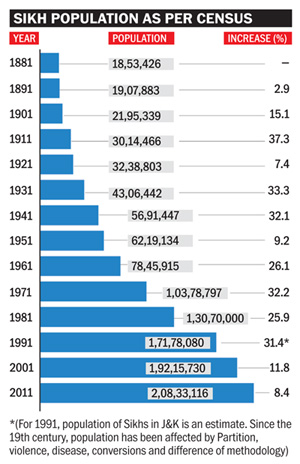
Immigration of non-Sikhs: This is blamed for the dilution of the Sikh population in Punjab. As long as the politics has to be done on religious and caste lines, this will be a concern. If development, including agricultural, is any concern, then everybody realises the critical contribution the immigrant population makes in the state. The native population is largely engaged in more paying forms of labour. If the US and West Asia thought on these lines, their economies would come to a halt.
Conversion: The insular and rigid outlook of modern Sikh leadership — as opposed to the founders’ idea — has led to many castes with small numbers being either pushed out or not included despite their wanting to. A subsequent spurt of deras or increase of other religions’ numbers is now bothering the Sikh leaders. The fear is the medicine should not be worse than the disease. Taking up a confrontationist attitude — of which there has been evidence in recent years — can only make matters worse.
Sex ratio: This is the one and only real cause of worry. Among Sikhs, there are only 903 women per 1,000 men, the worst ratio among all religions. That means a poorer social health for the community, which will have economic implications as well. The motives for this ironically are the same that keep the population down — material interest. Economic security is a major factor in lower fertility rate, which is an average of 3.1 children per woman among Sikhs, against a national average of 3.8. And the preference for a male child also has roots in a misplaced notion of securing family assets. The voice of the leadership has been less than audible on this crucial reform.
All the reasons that have led to better reining in of the population growth among Sikhs are something to be proud of. Relatively a higher level of education among their women is one. Acceptance of modern concepts of birth control, awareness of the benefits of a smaller family, relatively a greater sense of economic security, all indicators of a progressive community, are something to be emulated by others, and not discounted, as is being done by the Sikh leadership.
India by all projections is headed to overtake China in numbers sometime before 2030. If communities have to compete in numbers, the larger national goal of population control can never be attained. Sikhs could rightfully see themselves as flag-bearers of this wise cause. In a knowledge economy, the strength and influence does not come from numbers, but quality of the human resource.
There may be many challenges the Sikhs face, population is not one of them.
 Kids Portal For Parents India Kids Network
Kids Portal For Parents India Kids Network







